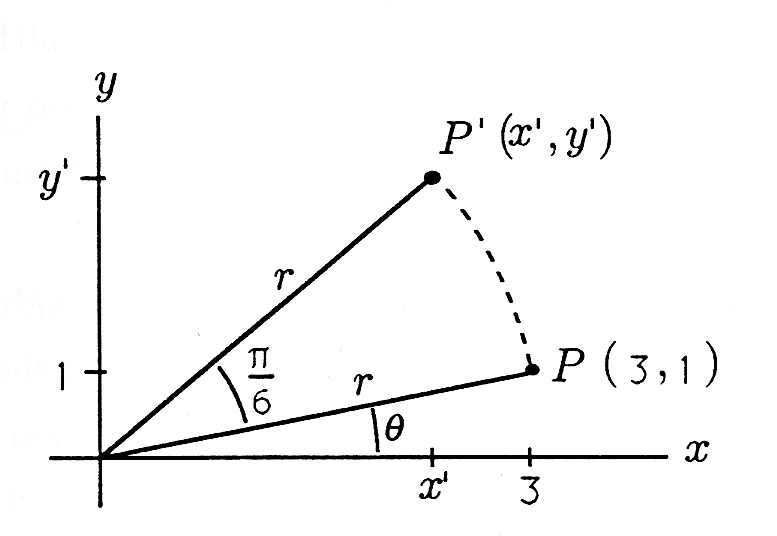| << Chapter < Page | Chapter >> Page > |
In this chapter we introduce matrix data structures that may be used to represent two- and three-dimensional images. The demonstration program shows students how to create a function file for creating images from these data structures. We then show how to use matrix transformations for translating, scaling, and rotating images. Projections areused to project three-dimensional images onto two-dimensional planes placed at arbitrary locations. It is precisely such projections that we use to get perspective drawings on a two-dimensional surface of three-dimensional objects. The numerical experiment encourages students to manipulate a star field and view it from several points in space.
Once again we consider certain problems essential to the chapter development. For this chapter be sure not to miss the following exercises: Exercise 2 in "Two-Dimensional Image Transformations" , Exercise 1 in "Homogeneous Coordinates" , Exercise 2 in "Homogeneous Coordinates" , Exercise 5 in "Three-Dimensional Homogeneous Coordinates" , and Exercise 2 in "Projections" .
Pictures play a vital role in human communication, in robotic manufacturing, and in digital imaging. In a typical application of digital imaging, a CCD camera records a digital picture frame that is read into the memory of a digital computer. The digital computer then manipulates this frame (or array) of data in order to crop, enlarge or reduce, enhance or smooth, translateor rotate the original picture. These procedures are called digital picture processing or computer graphics . When a sequence of picture frames is processed and displayed at video frame rates (30 frames per second), then we have an animated picture.
In this chapter we use the linear algebra we developed in The chapter on Linear Algebra to develop a rudimentary set of tools for doing computer graphics on line drawings. We begin with an example: the rotation of a single point in the plane.
Point has coordinates in the plane as shown in Figure 1 . Find the coordinates of the point , which is rotated radians from .

To solve this problem, we can begin by converting the point from rectangular coordinates to polar coordinates. We have
The rotated point has the same radius , and its angle is . We now convert back to rectangular coordinates to find and for point :
So the rotated point has coordinates (2.10, 2.37).
Now imagine trying to rotate the graphical image of some complex object like an airplane. You could try to rotate all 10,000 (or so) points in thesame way as the single point was just rotated. However, a much easier way to rotate all the points together is provided by linear algebra. In fact, with asingle linear algebraic operation we can rotate and scale an entire object and project it from three dimensions to two for display on a flat screen or sheetof paper.
In this chapter we study vector graphics , a linear algebraic method of storing and manipulating computer images. Vector graphics is especiallysuited to moving, rotating, and scaling (enlarging and reducing) images and objects within images. Cropping is often necessary too, although it is a littlemore difficult with vector graphics. Vector graphics also allows us to store objects in three dimensions and then view the objects from various locationsin space by using projections.
In vector graphics, pictures are drawn from straight lines.A curve
can be approximated as closely as desired by a series of short, straight lines.Clearly some pictures are better suited to representation by straight lines
than are others. For example, we can achieve a fairly good representation ofa building or an airplane in vector graphics, while a photograph of a forest
would be extremely difficult to convert to straight lines. Many computer-aided design (CAD) programs use vector graphics to manipulate mechanical
drawings.
When the time comes to actually display a vector graphics image, it may be necessary to alter the representation to match the display device. Personal computer display screens are divided into thousands of tiny rectanglescalled picture elements , or pixels . Each pixel is either off (black) or on (perhaps with variable intensity and/or color). With a CRT display, the electron beam scans the rows of pixels in a raster pattern. To draw a line on a pixeldisplay device, we must first convert the line into a list of pixels to be illuminated. Dot matrix and laser printers are also pixel display devices, while pen plotters and a few specialized CRT devices can display vector graphicsdirectly. We will let MATLAB do the conversion to pixels and automatically handle cropping when necessary.
We begin our study of vector graphics by representing each point in an image by a vector. These vectors are arranged side-by-side into a matrix containing all the points in the image. Other matrices will be used asoperators to perform the desired transformations on the image points. For example, we will find a matrix , which functions as a rotation: the matrix product represents a rotated version of the original image .

Notification Switch
Would you like to follow the 'A first course in electrical and computer engineering' conversation and receive update notifications?